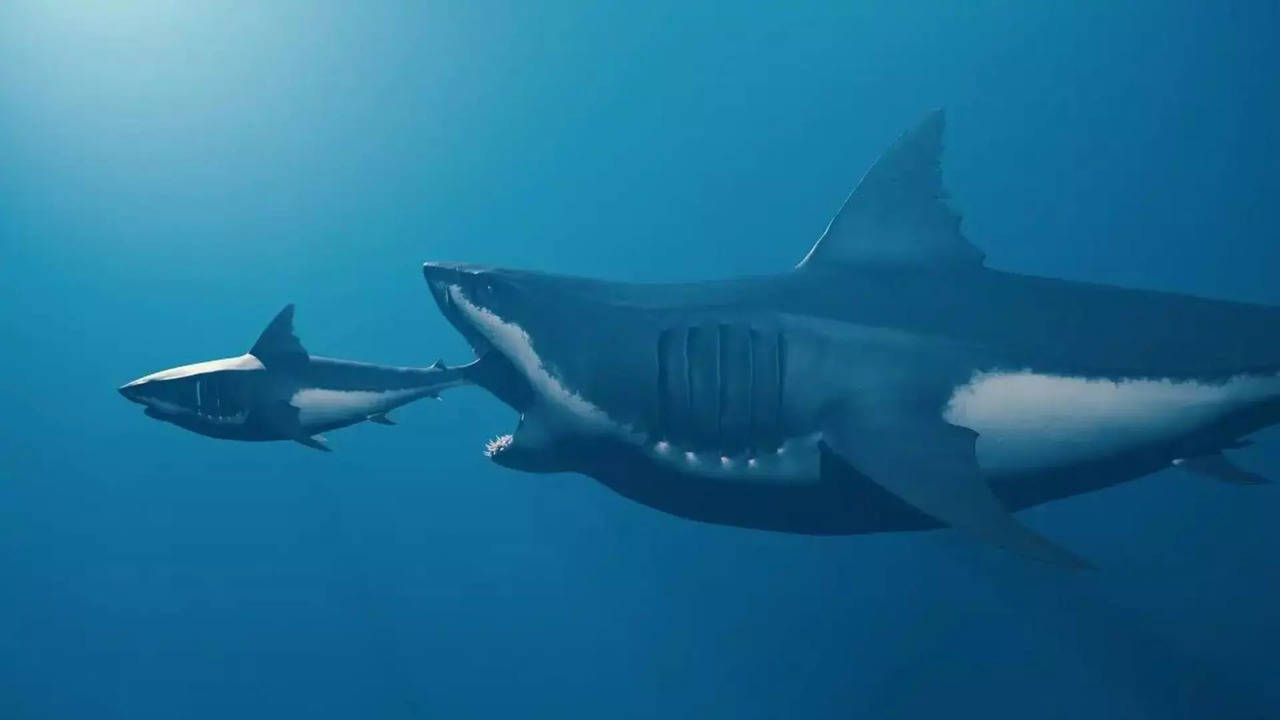Megalodon was apex predator 'at the highest level' ever and ate anything it wanted
Findings of a new research suggest Megalodons and their ancestors - collectively known as megatooth sharks - may have been “hyper apex predators”, occupying the highest rung of the prehistoric food chain. If that’s true, it could change our understanding of what drove the sharks—that could grow 15 to 18 metres in length—to extinction.

A large predator eats a smaller shark | Picture courtessy: Baris-Ozer/iStock
Photo : iStock
KEY HIGHLIGHTS
- Researchers at Princeton University found that Megalodons were two levels above great white sharks on the food chain.
- They analysed chemical signatures of dozens of Megalodon teeth, the last-standing body part virtually immune to decomposition.
- Megalodon and their ancestors showed the greatest nitrogen isotope excesses ever measured, which directly correlates to their position.
Sharks are the poster child of aquatic predators but even among these large, scaly hunters, one prehistoric species takes the cake - the Megalodon.
Bigger than the biggest sharks, these marine behemoths dominated the ocean and could literally eat anything they wanted before they went extinct some 3.6 million years ago.
The earliest of Megalodons appear in the fossil record 20 million years in the past.
Apex predators at the highest level
Nitrogen signatures of dozens of fossilised teeth from a new research suggest some Megalodons and their ancestors may have been “hyper apex predators”, occupying the highest rung of the prehistoric food chain.
If that’s true, it could change our understanding of what drove the sharks-that could grow 15 to 18 metres in length - to extinction.
“We’re used to thinking of the largest species — blue whales, whale sharks, even elephants and diplodocuses — as filter feeders or herbivores, not predators,” said Emma Kast, the first author of the study published in Science Advances. "“But Megalodon and the other megatooth sharks were genuinely enormous carnivores that ate other predators, and Meg went extinct only a few million years ago.”
Researchers at Princeton University examined fossilised teeth to compare the diets of marine animals - from polar bears to prehistoric great white sharks - and found that megalodons may have been at the highest trophic levels ever measured.
They analysed the teeth for nitrogen isotopes—varieties of nitrogen with different number of neurons.
Animals higher on the “food web” are known to have more N-15 isotopes.
However, so far, ecologists have only been able to use the technique to study extant creatures because nitrogen levels are too low in prehistoric fossils.
Researchers overcame this fundamental problem by feeding their samples to microbes that converted nitrogen from the enamel of the teeth into a chemical that’s easier to measure and voila - a monumental finding emerged.
Megalodon and its direct ancestors were found to have nitrogen isotope excesses higher than any marine animal. Compared to modern great whites, the megatooth sharks, as they are collectively known, were on average two levels higher on the food chain.
Megalodons may have eaten the monster-sized predators that ate great white sharks.
The findings of the study, however, contradict a May 2022 research that suggested Megalodons and great white sharks may have been on the same level of the food chain and preyed on the same animals. The ensuing competition, according to the study, piled on the factors that caused megatooth sharks to go extinct.
Except, it used a different method to draw its conclusions-studying zinc isotopes.
“It could be that we don’t have a total understanding and grasp of this technique,” Sora Kim, a paleoecologist at the University of California, Merced who was involved in both studies, told Science News. “But if [the more recent study] is right, that’s crazy.”
Trending:
End of Article
Subscribe to our daily Newsletter!
Related News





Bizarre! Pharma Students Pass Exam In UP After Writing ‘Jai Shree Ram’, Cricketers’ Name In Answer Sheet

Watch: Young Fan Breaks Down After Pakistan Suffers Third Defeat To New Zealand

Who Really is Belle Gibson? Documentary Exposes 'Instagram's Worst Con Artist'

Heartwarming Viral Video Shows Elephants Bhama and Kamatchi's 55-Year Friendship. Watch

'Unbelievable': Car's Wheels Installed Upside Down Leaves Internet in Shock | Watch








